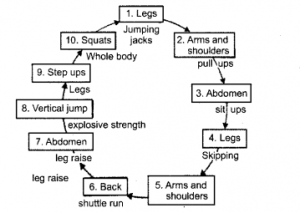
Circuit Training Method is one of the most important exercise in the world. It contains certain exercises of various kinds are performed with or without apparatus with given dosage. Today we will discuss about Circuit Training Method: Meaning, Characteristics, Examples
Circuit Training Method: Meaning, Characteristics, Examples

Meaning
Circuit training method was developed by Adamson and Morgan of leads University in 1957. It is a specific arrangement of exercises, performed systematically and repeatedly as circuit. Circuit training meaning consists of various exercises.
Meaning of circuit training
The circuit training’s main aim is to develop endurance and strength simultaneously. Flexibility and mobility are also considered its objectives.
Characteristics
Following are the main characteristics of circuit training method:

- Exercises are simple to learn and simple to execute.
- Exercises are performed with medium resistance or with medium weight.
- Number of repetitions is more.
- Its aim is the development of endurance and strenght.
- It involves exercises of whole body parts.
- It is given to the sportsman in the preparatory period for developing basic endurance and strength.
- The training must be performed under gradually increasing strain.
Examples

Here some examples of circuit training method:
1. Running on the spot.
2. Throwing medicine ball and catching it again 15 to 20 times.
3. Splits squat jumps 15 to 20 times.
4. Carrying weight or partner on shoulder 30 to 50 metres.
5. Chins ups 5 to 10 times.
6. 50 metre runs with sub maximum speed.
7. Push ups 10 to 20 times.
8. Standing jumps 10 to 20 times.
9. Sit ups from supine position 10 to 20 times.
10. Rope skipping 1 to 2 minutes.
11. Dips 15 to 20 times.
12. Half squats with weight.
13. Rope climbing, once or twice.
14. To perform bench press.
15. Bench press in sitting position.
Many exercises can be included in this traning method, such as dumb bells, bar bell, free hand exercises, frog jumps, different weight training exercises and hurdling etc. It is essential to note that the muscles, which were involved in first exercise, should not be involved in the next exercise. It means that exercise of the whole body parts should be given in alternate manner. There should be no pause or very little pause after each exercise. In circuit training, there should be at least 10 stations.
Exercise can be changed according to the requirement of the game and efficiency, of the sportspersons.
Aims of Circuit Training Method
- The quick pace and constant changing nature of circuit training places a unique type of stress on the body, which differs from normal exercises activites, like, weight training and aerobics.
- The demands of circuit training tend to prepare the body in the very even, all round manner.
- Large number of players can be trained at same time.
- Circuit training does not require expensive equipment.
- Circuit training is an exceptional forum of exercise, which aids in the prevention of injury. Circuit training is the best way to condition for all the parts of the body. Hence, total fitness is developed
- Circuit training is time efficient. No wasted time between sets. It gives maximum result in minimum time
- Its main aim is the development of endurance and strength. It is given to the sportsman in the preparatory period for developing basic endurance and strength.
Advantages of Circuit Training Method

Following are the main advantages of Circuit Traning Method:
1. Circuit training can be performed indoors or outdoors. In rainy season, this training can be done in rooms.
2. The equipment for exercise can be provided easily
3. It is easy to learn. A trainee can learn to train himself.
4. The trainee gains good result ina short period.
5. It is an interesting method of training.
6. It does not require long duration to perform exercises.
7. A number of athletes can do circuit training according to the stations at the same time.
8. The coach can easily watch and supervise the training.
9. Amount of training can be increased or decreased according to the ability of trainees.
10. All body parts can be exercised.
High benefit in less time: If those who work in the body building area are left out, then nobody has time for hours to do a gym. Therefore circuit training is a very beneficial way for such people. In this you exercise more in the shortest possible time, due to which you save a lot of time.
Circumstance training involves endurance training and strength training, in which strength is strengthened along with the strength of the muscles. Everyone has a different approach to achieving fitness, if someone values endurance training, then emphasizes stress training. But by practicing circuit training, you get the benefit of these two workouts. Simultaneously, if you get many benefits from practicing circuit training, then you know about those benefits.
How to increase load in Circuit Training
Following points are important to increase the load in circuit training:
- Number of repetitions can be increased per exercise.
- frequency can be increased.
- Additional load can be increased.
- Interval between exercises can be reduced.
- Number of rounds in circle can be increased.
Top Exercises
- Best for chest exercise: The push-up.
- Best exercise for glutes: The squat.
- Best exercise for abs: The bicycle manoeuvre.
- Best exercise for the back: Pull-up.
- Best exercise for hamstrings: Swiss ball hamstring curl.
- Best exercise for upper arms: Triceps dips.
- Best exercise for thighs: The lunge.
- Best for waist: The side bridge
Upper-body
- Push ups
- Bench dips
- Back extensions
- Medicine ball chest pass
- Bench press
- Inclined press up
Core & trunk
- Sit ups (lower abdominal)
- Stomach crunch (upper abdominal)
- Back extension chest raise
Lower-body
- Squat jumps
- Compass jumps
- Astride jumps
- Step ups
- Shuttle runs
- Hopping shuttles
- Bench squats
Total-body
- Burpees
- Treadmills
- Squat thrusts
- Skipping
- Jogging
Types of yoga
- Classical yoga.
- 6.2 Buddhist yoga.
- 6.3 Jain yoga.
- 6.4 Yoga in Advaita Vedanta.
- 6.5 Tantric yoga.
- 6.6 Hatha yoga.
- 6.7 Laya Yoga and Kundalini yoga.
Types of yoga
- Ashtanga Yoga. Ashtanga means “eight limbs” and encompasses a yogic lifestyle. …
- Iyengar Yoga. Also based on the Eight Limbs of Yoga, Iyengar yoga is named after B.K.S. …
- Bikram Yoga. …
- Jivamukti Yoga. …
- Power Yoga. …
- Sivananda Yoga. …
- Yin Yoga.
I hope you should like the article Circuit Training Method: Meaning, Characteristics, Examples, Aims, Advantages, How to increase load in Circuit Training
